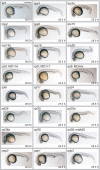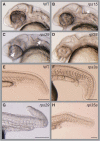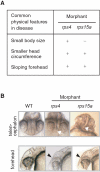Ribosomal protein gene knockdown causes developmental defects in zebrafish
- PMID: 17183665
- PMCID: PMC1762390
- DOI: 10.1371/journal.pone.0000037
Ribosomal protein gene knockdown causes developmental defects in zebrafish
Abstract
The ribosomal proteins (RPs) form the majority of cellular proteins and are mandatory for cellular growth. RP genes have been linked, either directly or indirectly, to various diseases in humans. Mutations in RP genes are also associated with tissue-specific phenotypes, suggesting a possible role in organ development during early embryogenesis. However, it is not yet known how mutations in a particular RP gene result in specific cellular changes, or how RP genes might contribute to human diseases. The development of animal models with defects in RP genes will be essential for studying these questions. In this study, we knocked down 21 RP genes in zebrafish by using morpholino antisense oligos to inhibit their translation. Of these 21, knockdown of 19 RPs resulted in the development of morphants with obvious deformities. Although mutations in RP genes, like other housekeeping genes, would be expected to result in nonspecific developmental defects with widespread phenotypes, we found that knockdown of some RP genes resulted in phenotypes specific to each gene, with varying degrees of abnormality in the brain, body trunk, eyes, and ears at about 25 hours post fertilization. We focused further on the organogenesis of the brain. Each knocked-down gene that affected the morphogenesis of the brain produced a different pattern of abnormality. Among the 7 RP genes whose knockdown produced severe brain phenotypes, 3 human orthologs are located within chromosomal regions that have been linked to brain-associated diseases, suggesting a possible involvement of RP genes in brain or neurological diseases. The RP gene knockdown system developed in this study could be a powerful tool for studying the roles of ribosomes in human diseases.
Conflict of interest statement
Figures




References
-
- Wool IG. The structure and function of eukaryotic ribosomes. Annu Rev Biochem. 1979;48:719–754. - PubMed
-
- Noller HF. RNA structure: reading the ribosome. Science. 2005;309:1508–1514. - PubMed
-
- Klein DJ, Moore PB, Steitz TA. The roles of ribosomal proteins in the structure assembly, and evolution of the large ribosomal subunit. J Mol Biol. 2004;340:141–177. - PubMed
-
- Lambertsson A. The Minute genes in Drosophila and their molecular functions. Adv Genet. 1998;38:69–134. - PubMed
Publication types
MeSH terms
Substances
LinkOut - more resources
Full Text Sources
Molecular Biology Databases

